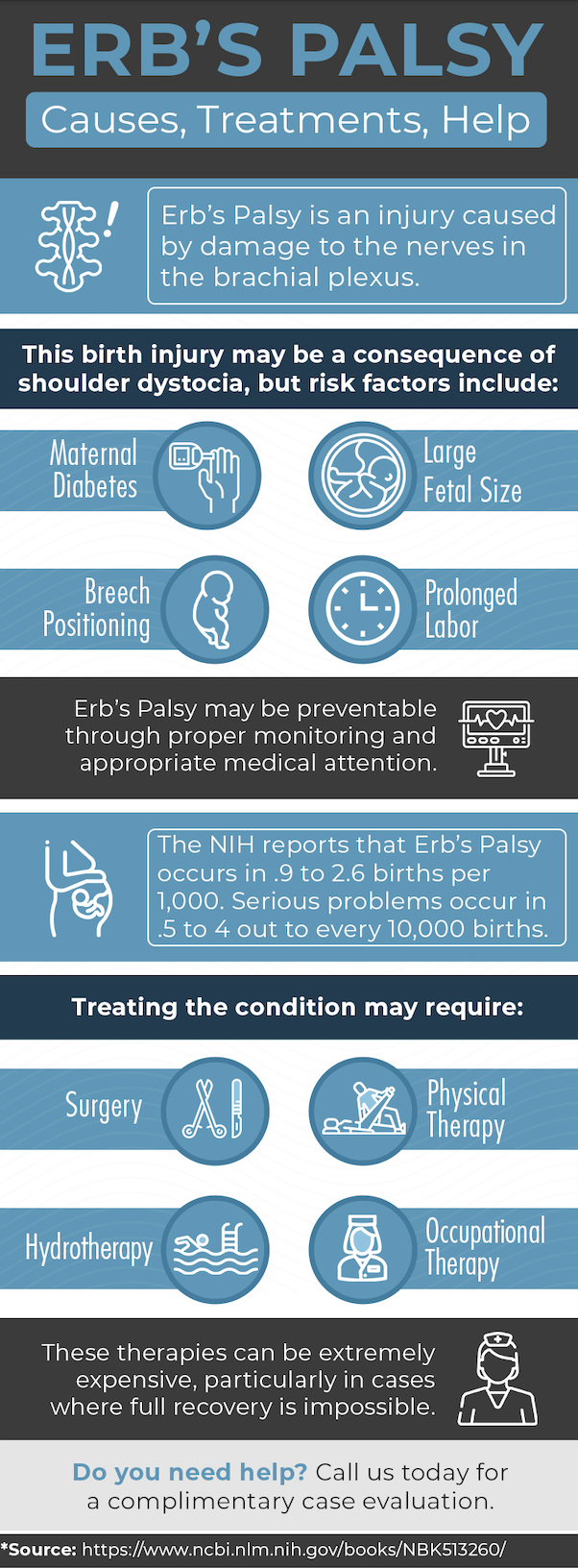
Atlanta Brachial Plexus Injury Lawyer: Georgia Shoulder Dystocia & Birth Injury Specialist
SERIOUS CASES. SERIOUS TRIAL LAWYERS. SERIOUS RESULTS.
$
600
MILLION
Whistleblower Case
$
42
MILLION
Medical Malpractice
$
40
MILLION
Medical Malpractice
$
25.9
MILLION
Medical Malpractice
$
18
MILLION
Automotive Products Liability
VIEW MORE
Introduction to Birth Injuries
Birth injuries can have life-altering consequences for both children and their families, especially when they involve the brachial plexus. These types of injuries often occur during the delivery process, particularly in situations involving shoulder dystocia—when a baby’s shoulder becomes trapped behind the mother’s pubic bone. When this happens, the delicate nerves of the brachial plexus can be stretched or torn, leading to serious complications such as arm paralysis, weakness, or limited mobility. In the most severe cases, brachial plexus injuries can result in permanent disability, affecting a child’s ability to use their arm for life. Understanding how these injuries occur and the impact they can have is essential for families who are navigating the aftermath of a difficult birth and considering their legal options.
What is Shoulder Dystocia?
Shoulder dystocia is a complication that happens during a childbirth when the shoulders of an infant are stuck inside the mom’s pelvis at delivery. In these situations, the baby’s shoulder can become impacted or stretched during delivery, leading to nerve injuries such as Erb’s Palsy. Our law firm has extensive experience with Atlanta Erb’s Palsy and represents families in such cases. The American Association of Family Physicians calls shoulder dystocia, “one of the most frightening emergencies in the delivery room,” while noting that “calm and effective management” is entirely possible – so long as the issue is properly diagnosed and swiftly dealt with.
Delivering physicians, midwives, and attendants are trained in special maneuvers that can be used to dislodge an infant’s shoulders without causing injuries to the baby or mother. However, if these maneuvers are not performed correctly, there is a risk of causing injuries, especially if excessive pulling on the baby’s shoulders occurs, which can result in nerve damage. While these emergency delivery methods may result in containable complications, such as maternal hemorrhaging, some instances of shoulder dystocia result in damage to the brachial plexus—a nerve cluster located between the shoulder and spinal cord—which may cause a permanent loss of function.
If your child suffered a birth injury, or if your child suffers from Erb’s Palsy, you should contact our Atlanta Erb’s Palsy lawyers for help. Our law firm has a proven track record in handling Erb’s palsy cases, and an experienced Erb’s palsy lawyer can guide you through the legal process to address your child’s injury and ensure timely legal action.
Understanding Brachial Plexus
The brachial plexus is a vital network of nerves that begins at the spinal cord and extends through the neck, shoulder, and into the arm. These nerves are responsible for controlling movement and sensation in the shoulder, upper arm, forearm, and hand. During birth, especially in complicated deliveries, the brachial plexus can be injured if the baby’s shoulder is forced downward while the head is being delivered. This type of plexus injury can stretch, tear, or even detach the nerves from the spinal cord, resulting in varying degrees of paralysis or weakness in the arm. Erb’s palsy is a common form of brachial plexus injury that specifically affects the upper arm, often causing noticeable weakness or loss of movement. Recognizing the signs of a brachial plexus injury early is crucial for prompt treatment and the best possible outcome for the child.
CAUSES AND RISK FACTORS
Brachial plexus injuries, including Erb’s palsy, most commonly occur when there is excessive pulling or pressure applied to a baby’s shoulder or head during the delivery process. Brachial plexus injuries, including Erb’s palsy, are among the most common birth injuries resulting from complications during delivery. Excessive pulling or pressure are leading causes of the most common birth injuries. This is especially true in cases of shoulder dystocia, where the baby’s shoulder becomes lodged against the mother’s pelvic bone as the infant moves through the birth canal. When healthcare providers use too much force or fail to follow proper procedures, the delicate brachial plexus nerves can be stretched, torn, or even detached, resulting in serious injury.
Certain risk factors increase the likelihood of these injuries. Babies born to mothers with gestational diabetes are at higher risk, as are those with a larger birth weight. A difficult delivery, such as one involving a long labor or the improper use of forceps or vacuum extraction, can also raise the chances of a brachial plexus injury. In some cases, medical negligence or errors in judgment during birth can directly cause these injuries. Understanding these risk factors is essential for families considering whether medical malpractice may have played a role in their child’s injury and whether legal action is warranted.
Top Atlanta Shoulder Dystocia Attorneys can help
If your child’s delivery was complicated by shoulder dystocia and your child sustained a permanent injury as a result, you may be entitled to compensation for all related damages. Please call the Atlanta office of Chance, Forlines, Carter & King at 404-760-7400 to schedule a complimentary consultation with one of our experienced birth injury attorneys right away.
GETTING STARTED WITH YOUR CASE
If your child has suffered a brachial plexus injury, such as Erb’s palsy, taking immediate action is important to protect your legal rights. The first step is to consult with an experienced birth injury attorney who understands the complexities of medical malpractice and plexus injury cases. During your initial free consultation, your attorney will review your child’s birth and medical history, gather relevant medical records, and assess the circumstances surrounding the injury.
Your lawyer will explain your legal options, including the possibility of filing a medical malpractice claim to seek fair compensation for your child’s injuries, medical bills, and future care needs. By working with a knowledgeable attorney, you can ensure that your child’s injury is thoroughly investigated and that your family’s interests are protected throughout the legal process.
NAVIGATING THE LEGAL PROCESS
The legal process following a birth injury can feel daunting, but you don’t have to face it alone. An experienced birth injury attorney will guide you through each stage, from the initial consultation to the resolution of your case, whether through settlement or trial. Your attorney will collaborate with medical experts to determine the cause and extent of your child’s injuries, evaluate the long-term impact, and build a strong case on your behalf.
Understanding the legal process, including important deadlines like the statute of limitations, is crucial to preserving your rights. With skilled legal representation, you can focus on your child’s recovery while your attorney handles the complex legal details, ensuring that your family receives the support and compensation you deserve.
Proving Negligence in Birth Injury Cases
In birth injury cases involving brachial plexus injuries or Erb’s palsy, proving negligence is a critical step toward securing justice for your child. This process involves demonstrating that the healthcare provider failed to uphold the accepted standard of care during pregnancy, labor, or delivery. Negligence may be established if the provider did not properly monitor the baby’s size and position, failed to recommend or perform a necessary cesarean section, or applied excessive force during the delivery process. Building a strong case requires gathering comprehensive medical records, consulting with medical experts, and collecting evidence that shows how the injury could have been prevented. An experienced birth injury attorney can help families navigate these complex legal requirements and advocate for their child’s rights.
SUPPORTING FAMILIES AFFECTED BY BIRTH INJURIES
Caring for a child with a brachial plexus injury or other birth injuries can be overwhelming, both emotionally and financially. In addition to seeking medical care and legal assistance, families benefit greatly from connecting with support networks and resources. Many organizations offer support groups, online communities, and educational materials to help families navigate the challenges of living with brachial plexus injuries.
Atlanta Erb’s palsy lawyers are committed to supporting families beyond the courtroom, providing guidance and connecting clients with valuable resources. By working together and accessing the right support, families can better manage their child’s injury, advocate for their needs, and move forward with hope and confidence.
BRACHIAL PLEXUS PALSY
There are four types of brachial plexus nerve injuries:
- Neuropraxia. A stretched and damaged nerve that is not torn
- Rupture. A torn nerve that is still attached to the spine
- Avulsion. A nerve root that is severed (torn) from the spinal cord
- Neuroma. An impacted nerve that cannot transmit signals
Klumpke paralysis is a specific type of brachial plexus injury that affects the hand and lower arm, resulting in paralysis or weakness in these areas. This is distinct from Erb’s palsy, which primarily affects the upper arm.
During an emergency delivery, it is possible for nerves in the armpit to move, tear, or completely detach, leading to nerve injuries. This often results in arm paralysis in the baby, a type of paralysis that may be accompanied by tremors or twitches, in the affected upper arm or lower arm. The absence or asymmetry of the Moro reflex in newborns can be an early sign of brachial plexus injury and should prompt prompt medical evaluation.
Occurring in an estimated four to 15 percent of births, most brachial plexus injuries in a baby self-resolve over the course of 12 months. However, around 10 percent of these cases result in a permanent loss of ability, and severe nerve injuries can lead to permanent disability or permanent paralysis. In such cases, surgery may be required to restore function.
Erb’s Palsy
Erb’s palsy occurs when the nerves in the upper brachial plexus are permanently damaged. This condition is marked by weakness in the arm, decreased grip strength, and decreased muscle and nerve development.
Children with Erb’s palsy may have one arm that is constantly bent at the elbow. They may also experience a complete loss of function in the affected arm.

Klumpke’s Palsy
Klumpke’s palsy occurs when the nerves in the lower brachial plexus are permanently damaged. This brachial plexus injury is marked by an inability to use specific muscles in the shoulder or arm, atrophy or weakness in wrist and finger muscles, and complete paralysis.
DIAGNOSIS AND TREATMENT
Diagnosing Erb’s palsy and other brachial plexus injuries typically begins with a thorough physical examination and a review of the child’s medical history. Common symptoms include arm weakness, paralysis, limited range of motion, and decreased muscle tone in the affected arm. To determine the extent of nerve damage, doctors may order specialized tests such as electromyography (EMG) or nerve conduction studies, which help assess how well the nerves are functioning.
Treatment for these injuries often starts with physical therapy, which is crucial for maintaining flexibility, preventing joint stiffness, and encouraging muscle development in the affected arm. In mild cases, most babies can achieve a full recovery with consistent therapy. However, more severe injuries may require surgical intervention to repair or graft damaged nerves. Early diagnosis and prompt medical care are vital for improving outcomes and minimizing long-term effects. Atlanta Erb’s palsy lawyers can help families access the medical care their child needs and pursue compensation to cover ongoing treatment and therapy.
PREVENTING BRACHIAL PLEXUS INJURY
Risk factors for shoulder dystocia complications include:
- A history of shoulder dystocia during labor
- Multiple birth delivery
- Maternal obesity
- Fetal macrosomia (large fetal size)
- Prolonged labor and delivery
- Induced labor
- Epidural use
Risks for shoulder dystocia are also increased in women with maternal diabetes. When potential complications such as these exist, OBGYNs and others involved during pregnancy can take precautionary measures by scheduling a C-section.
In cases where shoulder dystocia is unexpected, careful and deliberate maneuvering can significantly reduce risks for serious injury and permanent damage. If your child sustained a brachial plexus injury during delivery, you may have cause to file a birth injury lawsuit and seek compensation for medical expenses. Our attorneys are here to review your case, free of both cost and obligation, to help you determine the best course forward.
Seeking Justice and Compensation
When a child suffers a brachial plexus injury or Erb’s palsy due to medical negligence, families have the right to pursue justice and fair compensation. This compensation can help cover the costs of medical care, physical therapy, ongoing treatment, and other expenses related to the injury. It can also provide financial relief for pain and suffering, as well as any long-term impacts on the child’s quality of life. Working with an Atlanta Erb’s palsy lawyer ensures that your case is handled with the expertise and dedication needed to achieve the best possible outcome. Taking timely legal action is essential, as there are strict deadlines for filing birth injury claims. By holding healthcare providers accountable, families can secure the resources their child needs to recover and thrive.
CONTACT Chance, Forlines, Carter & King Now
To schedule your free consultation with one of our experienced attorneys, please call 404-760-7400 today. Located in Atlanta, we fight for families living throughout Georgia.
Schedule a Consultation Today. We represent clients in Atlanta, Augusta, Columbus, Macon, Savannah, Gainsville, Lawrenceville, Decatur, Jonesboro & All of Georgia.
PRACTICE AREAS
CASE RESULTS
TESTIMONIALS
"My siblings and I engaged Chance, Forlines, Carter & King, PC during an extremely stressful time in our lives, and we are thankful that they provided a warm working environment. We were highly impressed by their level of knowledge, their efficiency and their extreme professionalism. From our first contact to our very last conversation, we felt that our team at LCFCK genuinely cares about helping people."
V. FORD
READ MORE
